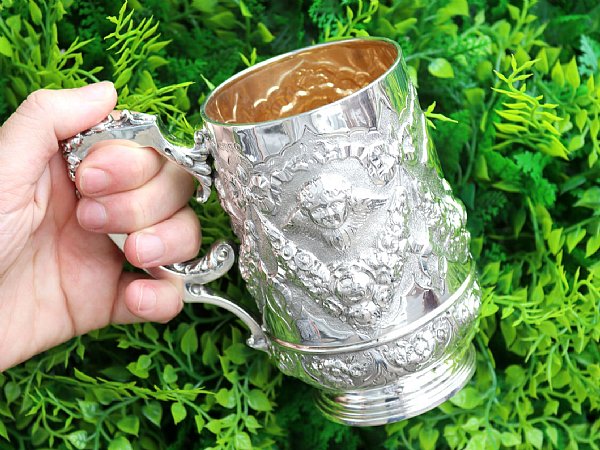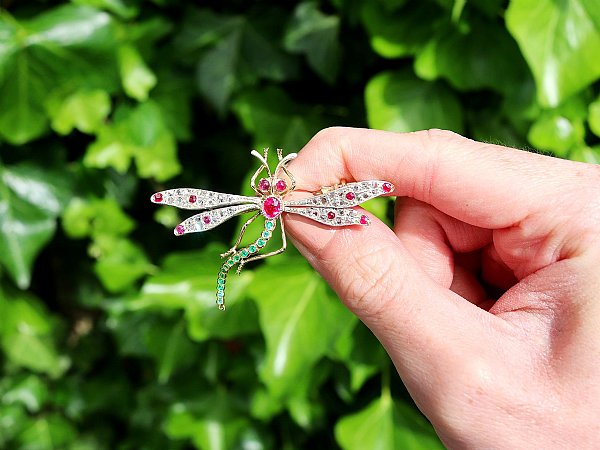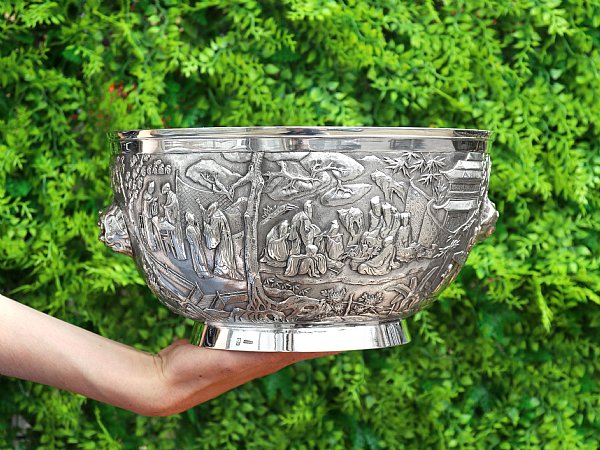Search Results for: '{{searchText}}'
Sorry...
We don't seem to have what you're looking for.
However we do have thousands of magnificent pieces of silver and jewellery available for you to view online. Browse our store using one of these categories.
Please wait for loading data... 
AC Silver have an extensive range of impressive antique and vintage silver mugs and tankards available for sale, with sizes ranging from small christening mugs, quart tankards to the peg tankard.
Andrew Campbell hand picks all of our vintage and antique silver tankards and mugs, and does so on merit having been retailing antique silverware since 1977.
Please browse our extensive collection above, all including FREE and INSURED international shipping.

The defining difference between tankards and other mugs is that tankards are crafted with lids. Existing from around the middle of the 1500s, the typically hold anywhere between a pint and half a gallon. Around the 1700s, quart tankards became a common standard. Early tankards are tall and narrow for the most part, with domed lids comparable to German steins. Production in England towards the end of the 17th century saw tankards becoming shorter and wider in size. There are still a few examples of large tankards from this era, although they became less popular by the 18th century.
Some variations on the tankard include the peg tankard. These tankards were made for sharing, with a line of pegs along the inside that could show how much of the beverage had been consumed. That way, the tankard could be passed around so everyone could have an equal amount. The peg tankard also gives way to well-judged drinking contest. One contestant would drink down to a peg in a single turn, followed by the next contestant. If you fail to reach the next peg, you pay up.
More examples of variety in tankard design could be seen through Scandinavian influences. In York, rounded tankards with pomegranate style feet and thumb pieces demonstrated the effects of Scandinavian designers in England.
Tankards were used all over northern Europe especially in Germany and the British Isles. They were also used in colonial America from the mid sixteenth century to the end of eightieth century and their designs varied accordingly.
The Elizabethan tankard, for example, had engraved or flat chased decoration to the body with continental influenced patterns and the classic S-scroll handle. Both the foot and cover were heavily embossed with designs depicting fruit and they featured a lobed thumbpiece and a cast finial.
By the 17th century, this design had been replaced by a plain cylindrical vessel with a flat topped lid. These tankards were simpler and usually only engraved with armorials. It was also around this time that the sizes of tankards increased and they were commissioned for ceremonial and presentational use, an applied skirt foot also became a popular feature. Due to the civil war which was taking place at this time tankards began to be crafted in a thinner gauge of silver.
Another interesting design variation in the 17th century was the peg tankard. This type of tankard had a vertical line of pegs on the inside. The tankard would be passed around as a form of wage: participants had to drink down to the next peg in one go. If not, there would be a forefeit to pay.
Silver tankards featuring domed lid originated during the 1800s and as the shape continued to alter, baluster/tulip-shaped bodies appeared. Some designs even included small whistles on the handles which were supposedly used for attracting a waiter’s attention.
During the 1700s, when the popular beverages changed from beer and ale to wine and spirits the tankard diminished in popularity, replaced with vessels such as goblets.
Tankards can vary in size, the most popular tankard sizes being half and quart tankards. The largest tankard on record was uncovered in wales and was two quarts- a four pint capacity!
The varying sizes correspond to different measures that were served. A quart is equal to two pints whereas a half tankard serves a pint. Interestingly, it is said this is where the phrase ”mind your P’s and Q’s” comes from, with the P’s and Q’s referring to the measure of alcohol. The bartenders in taverns would use this phrase to the customers to remind them "watch how much you are drinking”.
Today, the measurements served have been reduced by the world health organization and pint glasses have taken over. During the heyday of the tankard however, the vessels were used to serve the somewhat copious measurements that were expected at the time.
A popular Christening gift, children’s silver mugs have existed for several centuries. Traditionally used for serving hot drinks, silver was the preferred material due to the belief that it improves the taste of beverages. Less affluent families more commonly gave their children pewter mugs, supposedly diminishing the flavour of any beverages consumed using the vessel.
Although mugs have been made in several different sizes, we can be certain that there were mugs made specifically for children. We know this because some schools in the 18th century listed mugs as a requisite item that boys would need to bring to boarding school. Considering that Christening mugs are a well-documented gift, it is safe to assume that a significant proportion of mugs made in this smaller size were intended for children.
Most early examples of children’s mugs are a plain baluster shape, raised up from a sheet of silver by hammering the metal over a wooden stake. They were likely designed for their sturdiness and practicality over aesthetic attributes. In the 1760s, a barrel-shaped mug design appeared. The barrel shape was commonly enhanced with engraved hoops and staves. This design was popular for a period of time, with some examples in good condition being possible to find today.
By the mid-19th century, mugs became ornate in both form and decoration. Floral and foliate decoration was common in children’s mugs at this time. At the same time, however, Gothic arches also featured, paired with these popular flowery and fruity designs. Ornate Victorian christening mugs like these are very popular collectors’ items today. Many of these examples are decorated with attractive, extensive engraving, whether in the floral, foliate designs, or other designs.
Children’s silver mugs made in the 20th century were mostly imitations and adaptations of popular styles from previous centuries. Some 20th century mugs, however, feature designs contemporary to their time. Art Nouveau and Art Deco pieces are hard to find but do exist. Silver children’s mugs made today also commonly replicate popular designs from the past, making the hallmarks featured on silver mugs essential in dating them as items.
Initial hallmarks were haphazardly placed on the base of the mugs, although from the mid-Georgian period onwards they tend to be hallmarked in a neat line just below the rim, usually to the right of the handle.




